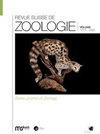Cave-adapted campodeids (Hexapoda, Diplura, Campodeidae) from the Dinarides and adjacent karst regions
IF 0.5
4区 生物学
Q4 ZOOLOGY
引用次数: 2
Abstract
Abstract: Five new species are described, Plusiocampa (Didymocampa) cvijici Sendra & Antić, sp. nov., Plusiocampa (Plusiocampa) atom Sendra & Antić, sp. nov., Plusiocampa (Stygiocampa) barethae Sendra & Rađa, sp. nov., Plusiocampa (Stygiocampa) dulcici Sendra & Rađa, sp. nov. and Plusiocampa (Venetocampa) pirnati Sendra & Borko, sp. nov. This brings the number of cave-adapted species of campodeids known from the Dinarides, Eastern Alps, Balkan System and Rodope Massif to 28 (one species in the genus Campodea and 27 in Plusiocampa). Among Plusiocampa, four out of five subgenera are present (Pentachaetocampa is not present in the region studied): Didymocampa (one species), Plusiocampa s. str. (15 species), Stygiocampa (eight species) and Venetocampa (three species), whereby Stygiocampa and Venetocampa are endemic to the studied region. These results reveal the importance of the Dinarides karst region as a centre of diversification for campodeids and for cave animals in general. A monophyletic subgroup, consisting of Stygiocampa, Venetocampa and Plusiocampa s. str. and characterized by the absence of medial posterior thoracic macrosetae, presumably colonized the Dinaric plate during the middle of the Cenozoic and occurs in that area since then.Dinarides和邻近喀斯特地区的洞穴适应的蟾蜍(六足目、双足目、蟾蜍科)
文摘:新发现了5个新物种:Plusiocampa (Didymocampa) cvijici Sendra & antiki, sp. nov., Plusiocampa (Plusiocampa) atom Sendra & antiki, sp. nov., Plusiocampa (Stygiocampa) barethae Sendra & Rađa, sp. nov., Plusiocampa (Stygiocampa) dulcici Sendra & Rađa, sp. nov.和Plusiocampa (Venetocampa) pirnati Sendra & Borko, sp. nov.。这使得从东阿尔卑斯山Dinarides已知的洞穴适应的campodeids物种数量增加。巴尔干系和Rodope山地至28种(Campodea属1种,Plusiocampa属27种)。在Plusiocampa中,有5个亚属中的4个亚属(Pentachaetocampa在研究区域不存在):Didymocampa(1种),Plusiocampa s.str .(15种),Stygiocampa(8种)和Venetocampa(3种),其中Stygiocampa和Venetocampa是研究区域特有的。这些结果揭示了Dinarides喀斯特地区作为营足类和洞穴动物多样化中心的重要性。一个由Stygiocampa、Venetocampa和Plusiocampa s.s str组成的单系亚群,其特征是没有内侧后胸粗毛,推测在新生代中期在Dinaric板块上繁衍,并从那时起在该地区出现。
本文章由计算机程序翻译,如有差异,请以英文原文为准。
求助全文
约1分钟内获得全文
求助全文
来源期刊

Revue Suisse de Zoologie
生物-动物学
CiteScore
1.30
自引率
12.50%
发文量
25
审稿时长
>12 weeks
期刊介绍:
The Revue suisse de Zoologie is a biannual journal published by the Geneva Museum and the Swiss Zoological Society. The Swiss Academy of Sciences and the City of Geneva provide financial support to the journal.
The Revue suisse de Zoologie publishes original results of zoological research, particularly in systematics and related fields.
 求助内容:
求助内容: 应助结果提醒方式:
应助结果提醒方式:


